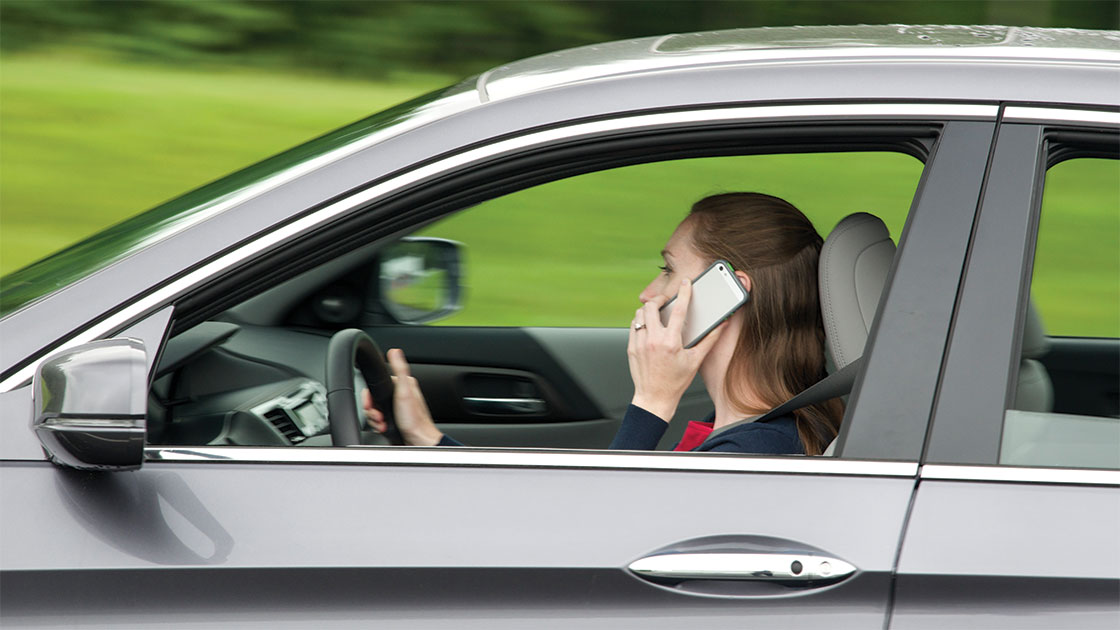Bans reduce phone use, but what about crashes?
October 24, 2014

State bans on hand-held phone use by all drivers have successfully curbed phone use behind the wheel but haven't produced a similar drop in crashes, previous analyses of insurance claims have shown. A new HLDI analysis indicates that even with strong enforcement, cellphone and texting bans aren't reducing crashes reported to insurers.
New York in 2001 became the first state to bar all drivers from talking on a hand-held phone while driving. Currently, 14 states and the District of Columbia restrict all drivers from using a hand-held cellphone. More states have targeted texting. Forty-four states and D.C. ban all drivers from text messaging.
Institute research has documented that all-driver bans on hand-held phone conversations can have large and lasting effects on phone use. Based on observations of drivers conducted up to seven years after bans were implemented in New York, the District of Columbia and Connecticut, the rates of driver hand-held cellphone conversations were an estimated 24-76 percent lower than would have been expected without a ban.
"Since we know that people have gotten into crashes while using cellphones, it's natural to expect crashes to decline following enactment of driver cellphone use bans. So far, though, this hasn't been the case for crashes reported to insurers," says Matt Moore, vice president of HLDI.
A 2009 analysis by HLDI found that hand-held cellphone bans had no effect on insurance claim rates, and a 2010 HLDI study found that texting bans aren't reducing insurance claims either.
Strong highway safety laws coupled with well-publicized enforcement are a proven countermeasure for changing driver behavior. This approach has worked to increase safety belt use and also to reduce the problem of alcohol-impaired driving.
Following this model, the National Highway Traffic Safety Administration (NHTSA) supported special enforcement demonstration programs in Hartford, Conn., and Syracuse, N.Y., aimed at reducing talking or texting on hand-held phones. Both states ban hand-held phone use and texting. Four waves of enforcement accompanied by media blitzes were conducted from April 2010 to April 2011.
The program was a success. After this high-intensity enforcement, the number of drivers observed holding a hand-held cellphone to their ear fell 57 percent in Hartford and 15 percent in the comparison communities of Bridgeport and Stamford, Conn. In Syracuse, the number of drivers observed engaged in hand-held phone conversations declined 32 percent. At the same time, the practice also decreased in the comparison community of Albany, N.Y., by 40 percent.
Observed rates of texting or otherwise manipulating hand-held phones also decreased sharply in both Hartford and Syracuse, while the comparison communities experienced only slight declines.
"NHTSA's study was well-done," says Adrian Lund, president of HLDI and IIHS. "It shows that good enforcement can change driver behavior. However, the question remains, is changing driver behavior enough to affect crash rates?"
To determine whether crash rates shrank as a result of the enforcement campaigns, HLDI analysts compared collision claims in the counties containing the cities of Syracuse (Onondaga County) and Hartford (Hartford County) with the comparison counties of Albany County, New York, and Fairfield County, Connecticut, and the rest of New York and Connecticut for the period of Jan. 1, 2009 through Oct. 31, 2011. HLDI didn't find a corresponding reduction in crashes reported to insurers from the program counties relative to the comparison counties, even though the rates of cellphone use and texting decreased in both program cities.
There are several possible reasons for the bans' lack of effect on crashes. One is that drivers who weren't using their phones may have been distracted by something else. The new IIHS-VTTI study indicates this may be the case.
Another is that drivers may have switched to hands-free calling, which is legal in both states. These drivers still may be distracted by their conversations even though their hands are on the wheel. It is difficult to estimate the prevalence of hands-free phone use. In NHTSA's observational surveys, drivers are coded as using a hands-free phone only if researchers can see them wearing an earpiece or headset. They don't count drivers who may be using a vehicle's Bluetooth-enabled system. Observed use of hands-free headsets declined in Hartford and the comparison communities following the enforcement waves, NHTSA reports. In Syracuse, the observed rate of headset use was essentially unchanged, while observed headset use decreased in the comparison community.
More recently, NHTSA sponsored additional high-visibility enforcement demonstrations between November 2012 and June 2013 in California and Delaware. Both states ban driver use of hand-held cellphones and texting. Results, which were released in April, were inconclusive. Although the observed rate of hand-held phone use declined in California and Delaware, the rate of hand-held phone use also fell in comparison communities. HLDI hasn't analyzed collision claims in these states in relation to the enforcement campaigns.
Separately, the Institute reviewed research on the effects of all-driver hand-held cellphone bans and texting bans as part of the March 2014 Engaged Driving Symposium organized by the Association for the Advancement of Automotive Medicine and sponsored by State Farm. The findings were mixed. As noted above, the evidence suggests that all-driver bans on hand-held cellphone conversations have resulted in long-term reductions in observed hand-held cellphone use. Drivers in ban states reported higher rates of hands-free cellphone use and lower overall cellphone use compared with drivers in non-ban states. However, bans on all cellphone use by teenage drivers haven't been shown to reduce their phone use. As for texting bans, it is unknown whether these are reducing the rate of texting at the wheel. The findings of 11 studies of the effects of bans on crashes, including two by HLDI, also were mixed. Several had methodological and other issues that limit their findings.
Drivers hang up cellphones amid use bans, strong enforcement in 2 states
Decline in cellphone use doesn't produce drop in crashes reported to insurers